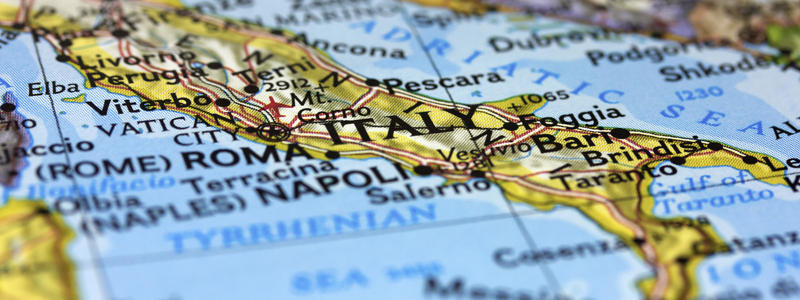Almost everyone is familiar with at least Pinot Grigio and Chianti when it comes to Italian wines, and a few more of us even know the 3 B’s, Barolo, Barbaresco and Brunello, but that’s pretty much where the familiarity with Italian wine stops for most of us. But there’s a lot of great and diverse wine that comes from the boot. In fact, Italy has authorized over 350 different varietals that can be used in winemaking; this fact alone is enough to make your head spin and cause you to realize there’s definitely more to Italy than just Chianti in a wicker basket.
With that in mind, here are six other Italian wines with which most American wine drinkers are unfamiliar. Put these wines on your radar!
Nero d’Avola
This red grape is Sicily’s baby, the most important and widely planted grape on the island. Its name translates to mean “black of Avola,” and, like many names that go back to ancient times, the reason for calling the grape Nero d’Avola is pretty simple: it was discovered in Sicily near the town of Avola and it has very dark, almost black, skin. Therefore its name: “black of Avola.” You’ve got to love the creativity.
If you’re a fan of Syrah/Shiraz, Nero d’Avola should be your Italian jam, as the characteristics of the wines are incredibly similar. The wine is full bodied, yet it has a velvety characteristic, as well as medium tannins that make it powerful, but not overpowering. It’s a great wine to drink with meat.
Dolcetto
This is a wine that used to be a secret of the Piedmontese. While the rest of the world was drinking their expensive Barolos and Barbarescos, Dolcetto stayed on their dinner table. An everyday sipper that’s perfect at room temperature or chilled, it’s wonderful to drink with a simple weeknight meal such as a fresh tomato salad with basil and olive oil and a nice roast chicken. It’s also an ideal pizza wine. After all, one can’t drink expensive Barolo or Barbaresco every night!
The name Dolcetto means “little sweet one,” and the wine is meant to be drunk young, only a year or two after it’s placed in the bottle. This is often the first red produced by Piedmont vineyards each year, as the grapes ripen quickly, and most times it sees no oak, instead fermenting in stainless steel, resting, and then heading straight to the bottle. This produces a fresh and lively wine with tons of fruit flavors that balance with the wines slight tannins and earthy texture.
Falanghina
This is a grape that can trace its lineage all the way back to antiquity, where during the Roman Empire it was possibly the most popular white wine available. And while it’s only really grown in the Campania region of Italy, Falanghina has been experiencing a bit of a comeback recently, which is lucky for this little grape, because during the last century when Italian winemakers were ripping up small regional grapes like this one in favor of varietals that were more popular on the international market, Falanghina barely survived. If it hadn’t we might never have been able to experience its distinctive tastes that are so refreshing and perfect for a warm day — crisp citrus with the scent of flowers. We’re glad the Campanians thought better than to rip these vines up.
Franciacorta
Prosecco isn’t the only sparkling wine in Italy, and, in fact, if you’re looking for a sparkler that’s more in the style of Champagne, Prosecco isn’t for you at all, Franciacorta is. Regarded as Italy’s finest sparkling wine — sorry Prosecco — Franciacorta actually hasn’t been around very long, only 53 years to be exact, but in that short amount of time, the wine has gained a strong following. The history of this delicious sparkler goes back to 1961 when a winemaker in the region had a hunch that the area could be capable of producing delicious sparkling wine on par with Champagne. His hunch was right, and now this wine is worth seeking out for anyone in the mood for some high quality bubbles.
Aglianico
Termed by many as “the Barolo of the South” for its similarities in flavor and texture to Italy’s most celebrated red wine, Aglianico is a red wine from the Campania and Basilicata regions of Italy, the southern part of the boot. It’s a savory age-worthyred wine with strong tannins and acidity that still has fantastic fruit flavors. The most famous of all Anglianico wines comes from the Taurasi region in Campania, and it’s these that will demand the highest prices, but venture outside of Taurasi (which, FYI, will be written prominently on the bottle if that’s where the wine originated) and Aglianico still flies somewhat under the radar, so when you find it, it’s usually at a great price.
Vermentino
This light white grape exists both in Northern Italy, as well as the island of Sardinia and produces racy, refreshing white wines that are perfect for cooling off from a hot summer’s day. Vermentino is a simple wine that’s perfect just as it is, not ever wine needs to be complex in order to be enjoyable, and it’s great for pairing with delicious coastal Mediterranean fare, from fresh seafood to light salads. Also, at just 12.5% in alcohol, it’s one of those wines you can drink glass after glass.
Header image via Shutterstock.com

